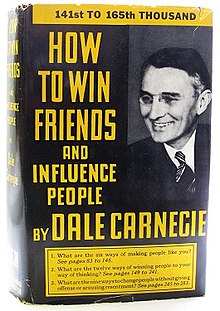How to Win Friends and Influence People

First edition, 11th printing (February 1937)
|
|
| Author | Dale Carnegie |
|---|---|
| Country | United States |
| Language | English |
| Subject | Self-help |
| Genre | Non-fiction |
| Publisher | Simon and Schuster (1936) |
|
Publication date
|
October 1936 |
| Media type | Print (Hardcover, Paperback) |
| Pages | 291 pp |
| ISBN | |
| OCLC | 40137494 |
How to Win Friends and Influence People is one of the first best-selling self-help books ever published. Written by Dale Carnegie (1888–1955) and first published in 1936, it has sold over 30 million copies world-wide, and went on to be named #19 on Time Magazine's list of 100 most influential books in 2011.
Leon Shimkin of the publishing firm Simon & Schuster took one of the 14-week courses given by Carnegie in 1934. Shimkin persuaded Carnegie to let a stenographer take notes from the course to be revised for publication. The original book contained sections providing colorful anecdotes and insightful wisdom. It gave instruction in handling people, winning friends, bringing people to your way of thinking, being a great leader, and navigating home life successfully. Carnegie combined age-old truisms with the emerging field of psychology to present a handbook in human relations which was interesting and accessible. Emphasizing the use of other's egotistical tendencies to one's advantage, Carnegie maintained that success could be found by charm, appreciation, and personality. The book sold exceptionally well from the start, going through 17 editions in its first year.
In 1981, a new revised edition containing updated language and anecdotes was released. The revised edition reduced the number of sections from 6 to 4, eliminating sections on effective business letters and improving marital satisfaction.
In 2011, a 3rd edition was released, titled "How to Win Friends and Influence People in the Digital Age". This edition was written by Dale Carnegie & Associates. It applies Carnegie's prescription for relationship and business success to the digital age.
The book has six major sections. The core principles of each section are explained and quoted below.
Before How to Win Friends and Influence People was released, the genre of self-help books had an ample heritage. Authors such as Napoleon Hill, Orison Swett Marden, and Samuel Smiles had enormous success with their self-help books in the late 19th and early 20th centuries. Dale Carnegie began his career not as a writer, but as a teacher of public speaking. He started out teaching night classes at a YMCA in New York and his classes became wildly popular and highly attended. The success of the classes in New York prompted YMCAs in Philadelphia and Baltimore to begin hosting the course as well. After even greater success, Carnegie decided to begin teaching the courses on his own at hotels in London, Paris, New York, Boston, Philadelphia, and Baltimore. Because he could not find any satisfactory handbook already in publication, Carnegie originally began writing small booklets to go along with his courses. After one of his 14-week courses, he was approached by publisher Leon Shimkin of the publishing house Simon & Schuster. Shimkin urged Carnegie to write a book, but he was not initially persuaded. Shimken then hired a stenographer to type up what he heard in one of Carnegie's long lectures and presented the transcript to Carnegie. Dale Carnegie liked the transcript so much he decided to edit and revise it into a final form. He wanted it to be extremely practical and interesting to read. To market the book, Shimkin decided to send 500 copies of the book to former graduates of the Dale Carnegie Course, with a note that pointed out the utility of the book for refreshing students with the advice they had learned. The 500 mailed copies brought orders for over 5,000 more copies of the book and Simon & Schuster had to increase the original print order of 1,200 quickly. Shimkin also ran a full page ad in the New York Times complete with quotes by Andrew Carnegie and John D. Rockefeller on the importance of human relations. Originally published in November 1936, the book reached the New York Times best-seller list by the end of the year, and did not fall off for the next two years. Simon & Schuster continued to advertise the book relying heavily on testimonials as well as the testable approach the book offered. Carnegie had created a new kind of book, one that was not read with passive interest, but rather a manual of active participation.
...
Wikipedia
